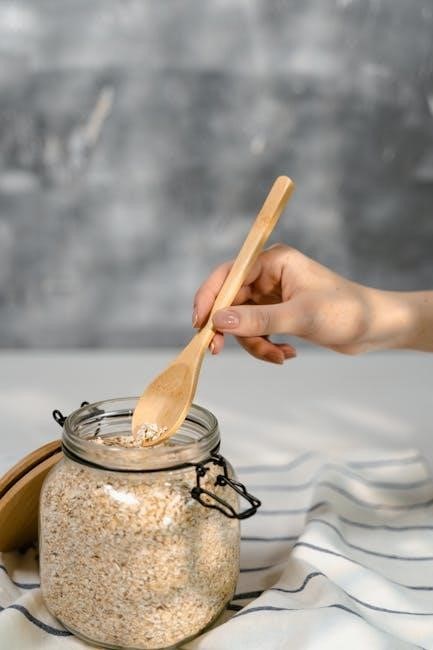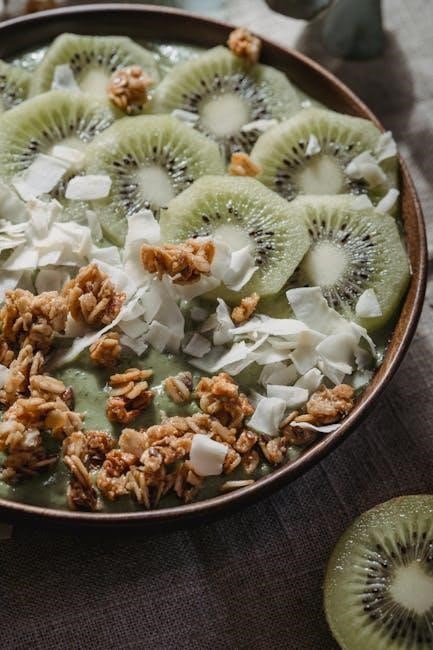This downloadable 7-Day GERD Diet Plan PDF provides a structured approach to managing GERD symptoms through dietary changes. It includes meal ideas, snack options, and tips to help alleviate acid reflux and promote digestion;
Understanding GERD and Dietary Approach
GERD, or Gastroesophageal Reflux Disease, is a chronic condition where stomach acid flows back into the esophagus, causing symptoms like heartburn, chest pain, and discomfort. While medications can help manage symptoms, dietary changes play a crucial role in reducing acid reflux and improving quality of life.
A GERD-friendly diet focuses on avoiding trigger foods that relax the lower esophageal sphincter or increase stomach acid production. Common triggers include citrus fruits, tomatoes, chocolate, caffeine, alcohol, and fatty or fried foods. Instead, the diet emphasizes low-acid, high-fiber foods that soothe the digestive system and prevent irritation.
Incorporating lean proteins, whole grains, and non-acidic vegetables can help stabilize digestion. Additionally, portion control and mindful eating habits, such as eating smaller meals and avoiding late-night snacks, are essential. By understanding how specific foods affect GERD symptoms, individuals can make informed choices to alleviate discomfort and promote long-term health. This dietary approach, combined with lifestyle modifications, can significantly reduce the frequency and severity of acid reflux episodes.
On the first day of the 7-Day GERD Diet Plan, the focus is on introducing foods that are gentle on the digestive system and help reduce acid reflux symptoms. Start with non-acidic fruits like bananas or melons, as they are less likely to trigger heartburn. Incorporate whole grains such as oatmeal or brown rice, which are high in fiber and can help stabilize digestion. Lean proteins like chicken or fish, cooked without added fats, are also ideal. Vegetables such as spinach, carrots, and green beans are excellent choices, as they are low in acid and rich in nutrients.
For breakfast, try oatmeal with a hint of ginger, which has natural anti-inflammatory properties. Lunch could include a salad with mixed greens, grilled chicken, and a light vinaigrette. Dinner might feature baked fish with steamed vegetables and a side of quinoa. Snacks like almonds or cucumber slices are great options. Avoid citrus fruits, tomatoes, and spicy or fatty foods. This day sets the foundation for a balanced and GERD-friendly diet.
Day 2: Incorporating Lean Proteins and Vegetables
On Day 2 of the 7-Day GERD Diet Plan, the focus shifts to incorporating lean proteins and vegetables that are easy to digest and reduce acid reflux symptoms. Start your day with a breakfast that includes scrambled eggs (prepared without added fats) or a smoothie made with spinach, almond milk, and a banana. These options are low in acid and rich in nutrients.

For lunch, consider grilled chicken breast or turkey slices paired with steamed vegetables like carrots, green beans, or zucchini. These foods are gentle on the stomach and help avoid triggering GERD symptoms. Dinner could feature baked cod or tofu, served with a side of quinoa or brown rice and sautéed vegetables like cabbage or broccoli. Snacks such as celery sticks with almond butter or a small portion of melon are excellent choices.
Key tips: Opt for lean proteins that are low in fat, as fatty foods can worsen reflux. Pair them with non-acidic vegetables to promote a balanced meal. Avoid spices or heavy seasonings that might irritate the digestive tract. By focusing on these foods, you can help manage GERD symptoms while maintaining a nutritious diet.
Day 3: Focus on Fiber and Digestion
On Day 3 of the 7-Day GERD Diet Plan, the emphasis is on increasing fiber intake to support digestion and reduce symptoms of acid reflux. A high-fiber diet can help prevent overeating and promote a feeling of fullness, which is beneficial for managing GERD.

Start your day with a fiber-rich breakfast, such as oatmeal topped with fresh berries, chia seeds, and a sprinkle of almond butter. For lunch, opt for a hearty salad with mixed greens, grilled chicken, and a variety of non-acidic vegetables like cucumbers, carrots, and bell peppers. Add a small portion of quinoa or brown rice for extra fiber.

Dinner could include roasted vegetables like Brussels sprouts, sweet potatoes, and zucchini, served with a side of whole-grain bread or wild rice. Snacks such as an apple with almond butter or a handful of baby carrots with hummus are excellent choices to keep your fiber intake steady throughout the day.

Key tips: Incorporate soluble fiber-rich foods like oats, barley, and vegetables, as they can help absorb stomach acid and improve digestion. Avoid processed or high-fiber foods that may cause bloating. Drinking water between meals, rather than during meals, can also aid digestion and prevent reflux. By focusing on fiber, you can support your digestive health and alleviate GERD symptoms effectively.
Day 4: Avoiding Trigger Foods
On Day 4 of the 7-Day GERD Diet Plan, the focus shifts to identifying and avoiding trigger foods that can exacerbate acid reflux symptoms. Common triggers include citrus fruits, tomatoes, chocolate, caffeine, alcohol, fried foods, and spicy dishes. These foods can relax the lower esophageal sphincter or irritate the esophagus, leading to heartburn and discomfort.
For breakfast, opt for non-acidic options like oatmeal with honey or scrambled eggs with spinach. Lunch could feature a grilled chicken salad with cucumbers, zucchini, and a light vinaigrette. Avoid adding tomatoes or cheese, which can trigger symptoms.

Snacks should include non-acidic fruits like bananas or melons, paired with a handful of almonds. Dinner might consist of steamed vegetables, such as carrots and green beans, served with a small portion of quinoa or brown rice.
Key tips: Be mindful of portion sizes and avoid lying down after meals. Keeping a food diary can help you identify specific triggers and tailor your diet accordingly. By eliminating these problematic foods, you can significantly reduce GERD symptoms and promote a healthier digestive system.
Day 5: Managing Portion Sizes
On Day 5 of the 7-Day GERD Diet Plan, the emphasis is on managing portion sizes to prevent overeating, which can exacerbate acid reflux symptoms. Eating smaller, more balanced meals throughout the day helps maintain a healthy digestion process and reduces pressure on the lower esophageal sphincter.
For breakfast, consider a small serving of non-acidic fruit like melon or berries, paired with a slice of whole-grain toast. Lunch could include a modest portion of lean protein such as turkey or tofu, accompanied by steamed vegetables like carrots and green beans. Snacks should be limited to small servings, such as a handful of almonds or a small rice cake with almond butter.
Dinner should consist of a small serving of baked fish like tilapia or cod, served with a side of quinoa and roasted vegetables like zucchini and bell peppers (avoiding spicy seasoning). Avoid eating within 2-3 hours of bedtime to prevent nighttime reflux.
By controlling portion sizes and spreading meals evenly, you can better manage GERD symptoms and promote a healthier digestive system.

Day 6: Incorporating Soothing Herbs
On Day 6 of the 7-Day GERD Diet Plan, the focus shifts to incorporating soothing herbs that can help calm the digestive system and reduce acid reflux symptoms. Certain herbs, such as ginger, chamomile, and licorice root, are known for their anti-inflammatory and digestive-soothing properties, making them ideal for GERD management.
Start your day with a warm tea made from fresh ginger or chamomile. For breakfast, try oatmeal with a sprinkle of cinnamon, which can also aid digestion. At lunch, add fresh parsley or basil to your meals for a mild, non-irritating flavor. Snacks can include a small portion of dried ginger or a soothing herbal tea.
Dinner might feature a vegetable stir-fry with turmeric and ginger, or a soothing soup made with licorice root and celery. Avoid overconsumption of any herb, as moderation is key. These herbs not only add flavor to your meals but also provide natural relief from GERD symptoms. By incorporating them thoughtfully, you can enhance your diet’s effectiveness in managing acid reflux.
Day 7: Long-Term GERD Management
Day 7 focuses on establishing sustainable habits for long-term GERD management. The goal is to maintain a balanced diet, avoid trigger foods, and incorporate lifestyle changes to prevent acid reflux. Start by reviewing your progress over the past week, identifying which foods and portion sizes worked best for you. Consider keeping a food diary to track patterns and reactions.

For breakfast, opt for a GERD-friendly smoothie with spinach, banana, and almond milk. Lunch could include grilled chicken with quinoa and steamed vegetables. Snacks might feature non-acidic fruits like melons or berries. Dinner should be light, such as baked cod with a side of roasted sweet potatoes and green beans.
To support long-term management, stay hydrated with water or herbal teas like chamomile or ginger. Avoid eating within 2-3 hours of bedtime and consider elevating the head of your bed to reduce nighttime reflux. Regular physical activity, such as gentle walks, can also improve digestion.
By adhering to these principles and staying consistent, you can effectively manage GERD symptoms and enhance your overall well-being. For continued guidance, download the 7-Day GERD Diet Plan PDF and use it as a reference for meal planning and lifestyle adjustments.

Additional Tips for GERD Management
To complement your 7-Day GERD Diet Plan, consider these additional strategies to manage symptoms effectively. First, practice portion control and eat smaller, more frequent meals to avoid overwhelming your digestive system. Avoid lying down immediately after eating, as this can trigger acid reflux. Incorporate gentle physical activity, such as walking, to improve digestion and overall health.
Stay hydrated by drinking water throughout the day, but avoid consuming large amounts during meals. Herbal teas, like ginger or chamomile, can also help soothe the digestive tract. Avoid tight clothing that puts pressure on the abdomen, as this can worsen reflux.
For long-term success, identify and avoid personal trigger foods while consistently incorporating GERD-friendly options. Consider keeping a food diary to track your symptoms and reactions to specific foods. Finally, consult a healthcare professional or dietitian to tailor your plan further and address any underlying issues. By combining these tips with your diet plan, you can achieve sustained relief from GERD symptoms.



